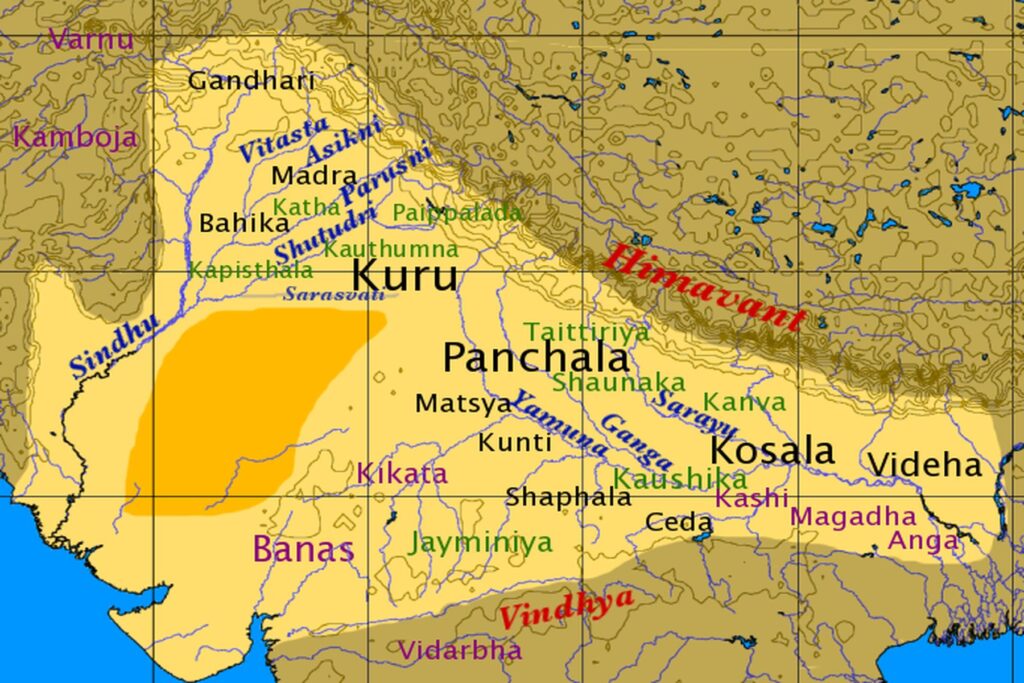
Early Vedic period

Geography
- Early Aryans lived near the Indus River and its surrounding areas, known as the Sapta-Sindhu region because of the seven rivers there.
- They also extended to the area around the Lost Saraswati River, which is now represented by the Ghaggar River in Rajasthan.
- During this time, they didn’t mention the sea, the Himalayas, or the Ganges River in their writings.
Administration of Early Vedic Age

Early Vedic Society:
- In the early Vedic society, there were instances of monarchy, but leadership wasn’t hereditary.
- The leader, called the Gopati or Gopa, wasn’t considered divine.
- Sometimes, leaders were elected by the tribal assembly known as the Samiti.
- The Rajan, or chief, had the role of protecting the people and their cattle and offering prayers to the gods.
- The Jana, or community, often battled with groups like the Panis who stole their cattle, and they sought the help of the Vedic god Indra in such conflicts.
Organisational Structure:
- The early Vedic society had governing bodies like the Sabha, Samiti, Vidhata, and Gana, which assisted the Rajan.
- Sabha had a few leaders, while Samiti was a larger assembly. Vidhata was the oldest member.
- Cattle were kept in places called “Gaun,” and the pursuit of lost cows was called Gavishthi.
- The society followed a patrilineal system with the family head called Kula.
Administration:
The Rig Society’s administration included:
- Purohit: Responsible for rituals and received Dakshina (gift) and Dana (donations).
- Senani: Leader of the army.
- Vrajapati: In charge of controlling the territory.
- Gramini: Leader of the village and the fighting unit.
Social Structure:
- The Jana was divided into smaller groups called Vis, which further had Kul or Kutumb units.
- The Kutumb had “Griha” as its basic unit, with Kulapa as its head, and Grihapati heading the Griha.
- Several Kula formed a gram, with a gramini as its leader.
Economy
- During this time, society mainly revolved around raising cattle, with agriculture as a secondary activity for their own needs. Wooden ploughshares were used, as mentioned in the Rig Veda.
- Cattle were the primary source of wealth. People cultivated crops like Yava, but mostly for personal use. There was no taxation, treasury, or mention of currency. A gold piece called Nishika is known, but barter, especially involving cows, was common for trade.
- Copper tools were found in regions like Punjab and Haryana, but iron was unknown. They referred to metals as “Ayas.”
- Horses were important, and various economic activities like hunting, carpentry, weaving, and metalwork were prevalent during this early Vedic period.
Social Life

Division of the society
- In this society, there were two main groups: the Aryans and the non-Aryans. The non-Aryans were known as the Dasas and Dasyus. The Aryans were generally kinder to the Dasas but not so friendly to the Dasyus.
- The society was organised into different clans, and even the leaders (Rajans) and priests (Purohits) belonged to these clan networks.
Varna System
- In the Vedic society, the idea of “Varna,” which means social class, was the key factor that set the Vedic people apart from the non-Vedic ones.
- This means that Vedic society wasn’t completely equal, and people had different roles based on their jobs and gender. However, during this period, the strict fourfold caste system we later see in India had not yet fully developed.
- The Vedic people also had slaves, but these slaves were mainly used for household work and not for farming.
Social Mobility
- In this time, people had some freedom to switch jobs, so there wasn’t a rigid social structure that limited them.
Position of Women
- Women had significant roles and education, with the right to participate in assemblies like Sabha and Samiti.
- They could also choose their own husbands, and customs like Sati and Purdah weren’t observed.
Institution of Marriage
- In early Vedic times, some people practised monogamous marriage, where one person married one spouse. But there were also practices like polygamy (having multiple spouses) and polyandry (multiple husbands).
- They had a custom called “Levirate,” where if a husband passed away, his younger brother would marry his widow. Another practice was “Niyoga marriage,” which involved a childless widow marrying her deceased husband’s brother temporarily to have children.
Religion
- During this time, there were no temples or idols for worship. Instead, people followed a simple and informal kind of worship, focusing on natural forces like wind, rain, and water. They made sacrifices to ensure the well-being of their community and cattle.
- Their worship aimed at things like having more children, protecting their cattle, having sons, and staying healthy. Families themselves performed the rituals, and chanting mantras (sacred words) was essential.
- They worshipped both male and female gods:
- Male gods included Indra (thunder), Agni (fire), Varuna (water), Soma (plants), Yama (death), Pushan (jungle and cattle), Vishnu (kind god), and Ashwini (war and fertility).
- Female goddesses included Savitri (sun), Aditi (eternity), Prithvi (earth), Nirrti (death), and Usha (dawn).



Leave a Reply